The Obama administration is finally admitting what industry experts and state-level actuaries have been forecasting for months, based on factors such as underperforming
Advertisement
The Obama administration said many consumers will see noticeable premium increases when buying health coverage on insurance exchanges in 2016, acknowledging for the first time what many health-care experts had predicted. Federal officials said Monday that the price of the second-lowest-cost midrange “silver plan”—a key metric for premiums around the country—will increase by 7.5% on average across the three-dozen states that rely on Washington to administer the health law for them. And 60% of enrollees—across 30 of the largest markets in the U.S.—will see the average rate for that benchmark plan rise by 6.3%, according to a Health and Human Services report on premium data that hasn’t yet been made fully public. The higher premiums are likely to intensify Republicans’ claims that the health law isn’t holding down costs... Some enrollees may see significantly higher or more modest rate increases. State insurance regulators around the country have largely approved all or most of the hefty premium increases sought by the largest health plans for 2016. Some have jumped by double digits: On average, premiums will rise in 2016 for the second lowest-cost silver plan by 31.5% in Alaska and 22.9% in Oregon, according to the report. Oklahoma will see a 35.7% hike...The administration is projecting about 10 million people will have paid up coverage through the federal and state exchanges by the end of 2009, only a slight bump from the 9.9 million with paid-up plans as of June. That means it will be increasingly important for the Obama administration to retain customers, a goal that could be more challenging amid the premium increases.
Recommended
Advertisement
The Journal piece goes on to remind readers of President Obama's blithe prediction in July that rates wouldn't jump too drastically, shrugging off the industry's early projections. Also, Obamacare's chronic failure to hold down costs isn't a "Republican claim." It's an incontrovertible fact -- for individuals, families and the federal government. The law's supporters continue to be dead wrong about cost curves. The Hill adds context on the rising premiums: "The increase is far more than last year’s two percent jump among benchmark silver plans. Those plans, the second-lowest cost option among silver plans, are important because they determine healthcare subsidies for people living in that area, even if they pick a different tiered plan." They quote administration officials spinning the spike as less drastic than it could have been in Obamacare's absence, a counterfactual that only reminds frustrated consumers of Democrats' pledge that everyone's rates would decrease under the law. USA Today jumps in with a helpful reminder that premiums are only one piece of the health costs puzzle:
The new report did not address the important issue of total out-of-pocket costs, which include deductibles, co-payments and other cost sharing. Many people who shop based on premium costs alone can be alarmed when they see how much they have to contribute to their health care on top of their monthly premiums. "Premiums are a part of the picture but not the whole picture," says Eric Gashko, assistant vice president for government affairs at the National Health Council, which represents people with chronic conditions. For people like the council's members, cost sharing is "often times a bigger driver of the cost than the premium would be," he says.
Advertisement
The average deductible under "bronze-level" plans last year was nearly $5,200. That's the amount of money a consumer would have to fork over in out-of-pocket costs before her insurance coverage -- into which she contributes monthly premium payments -- even kicks in. I'll leave you with nonpartisan investigators' latest findings of widespread waste and mismanagement within the law. As you read this, bear in mind that Obamacare was passed in 2010 and was implemented more than two years ago:
Federal investigators from the Government Accountability Office said Thursday that they had discovered many errors in eligibility decisions under the Affordable Care Act that had led the government to pay for duplicate coverage for some people and an excessive share of costs for others. The investigators said some people were receiving subsidies for private insurance at the same time they were enrolled in Medicaid. In other cases, the investigators said, the government is probably overpaying because it cannot always distinguish between newly eligible beneficiaries under the Affordable Care Act and those eligible under the old rules...Moreover, the auditors said, the Centers for Medicare and Medicaid Services, which runs the federal marketplace, “does not have procedures to automatically terminate subsidized exchange coverage when individuals are determined eligible for Medicaid.”
Advertisement
In response, the Obama administration mumbled something about "intensifying efforts" to address and fix these bugs, pointing to a data-matching program HHS recently launched to curb these issues. To which GAO investigators replied, not good enough. "The accountability office said this was not enough to minimize the potential for duplicate coverage. In a separate study, undercover investigators from the accountability office created 18 fictitious identities and filed applications in their names." Guess how many of those 18 managed to obtain coverage? Seventeen, "even though they used nonexistent Social Security numbers, invalid immigration document numbers, fictitious birth certificates and other counterfeit documents." The GAO's conclusion: "Our undercover testing for the 2015 coverage year found that the health care marketplace eligibility determination and enrollment process remains vulnerable to fraud." The report cited one example of a fake consumer receiving taxpayer subsidies through the federal exchange and two state exchanges simultaneously.

























Join the conversation as a VIP Member